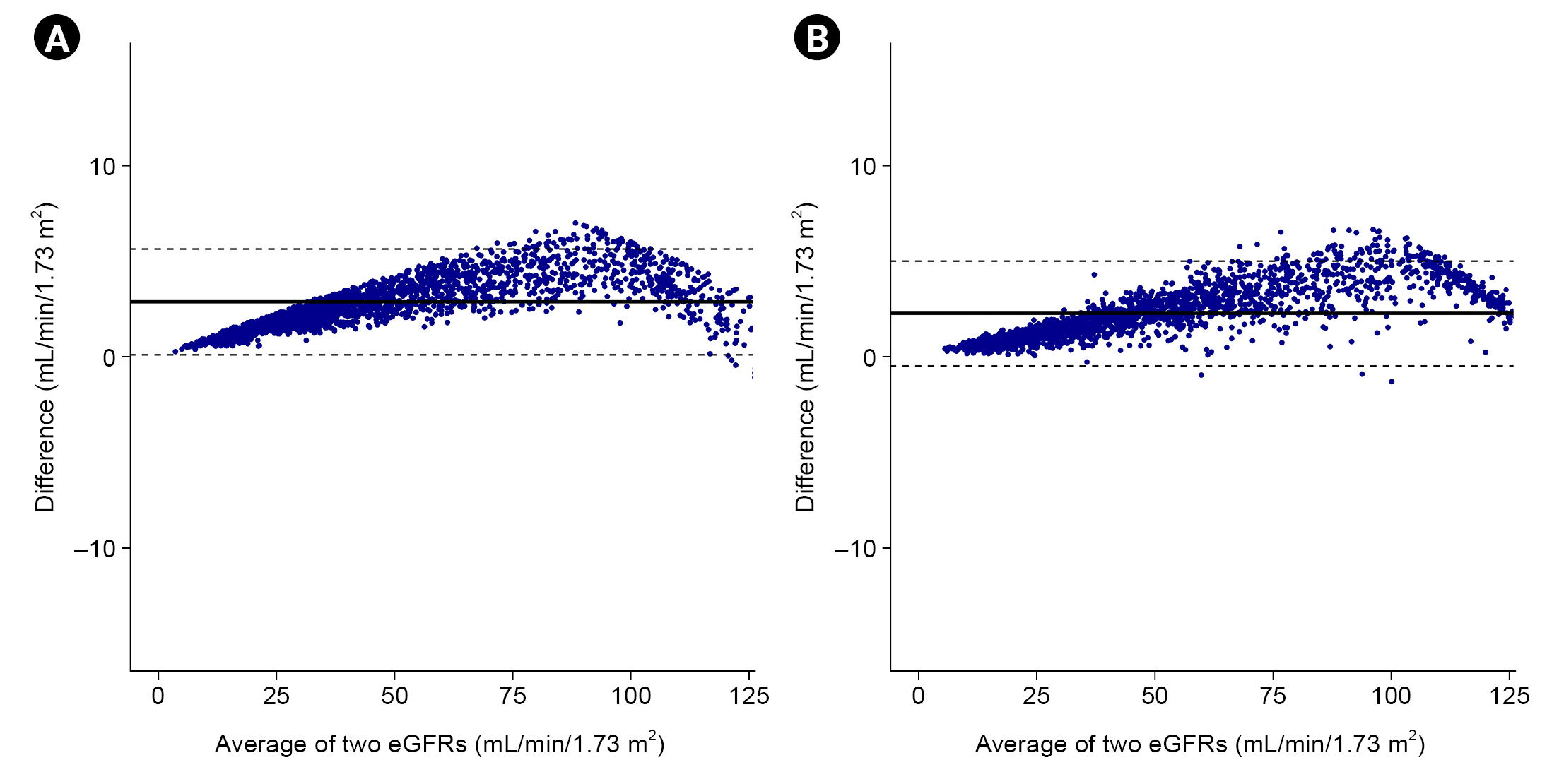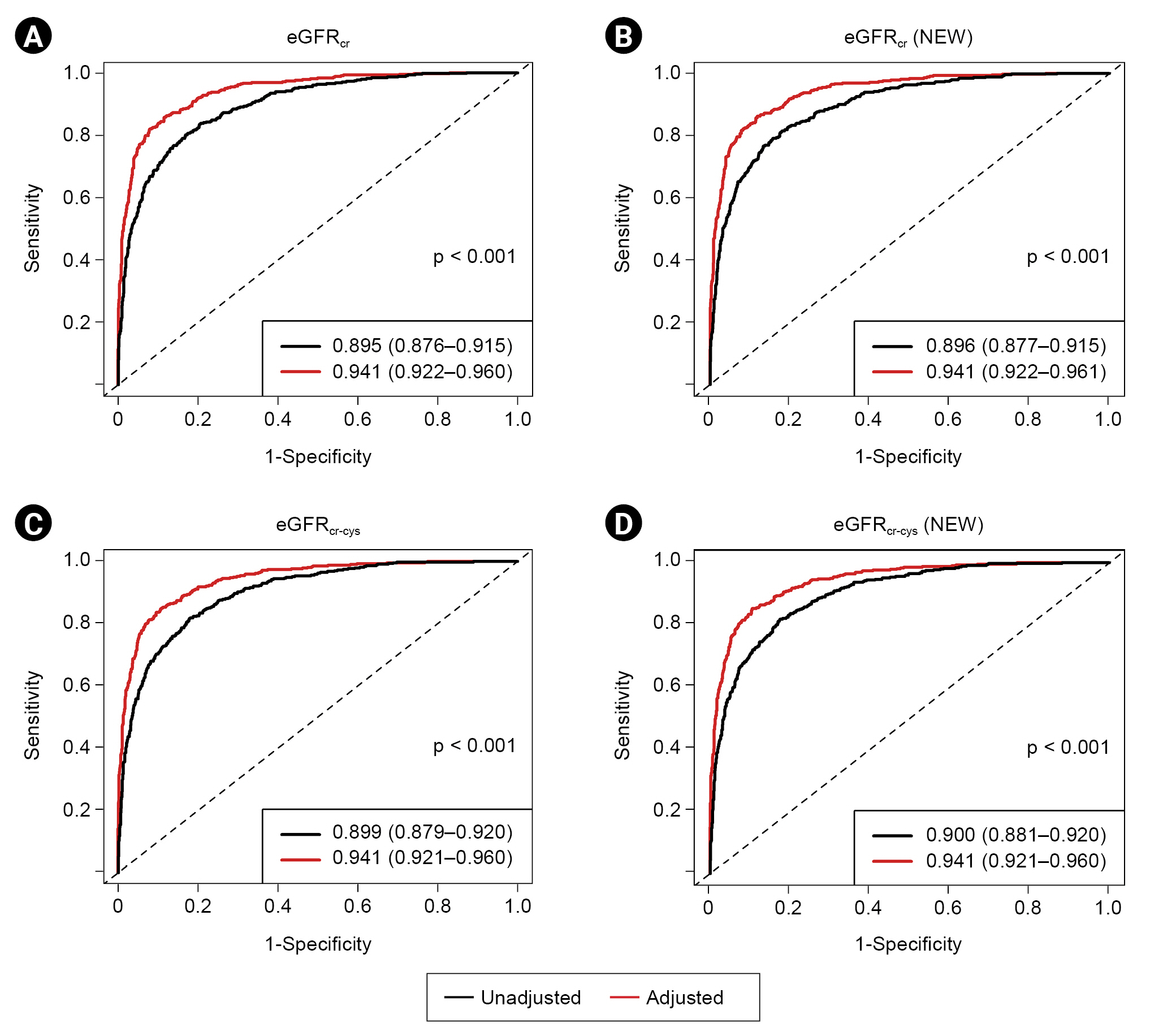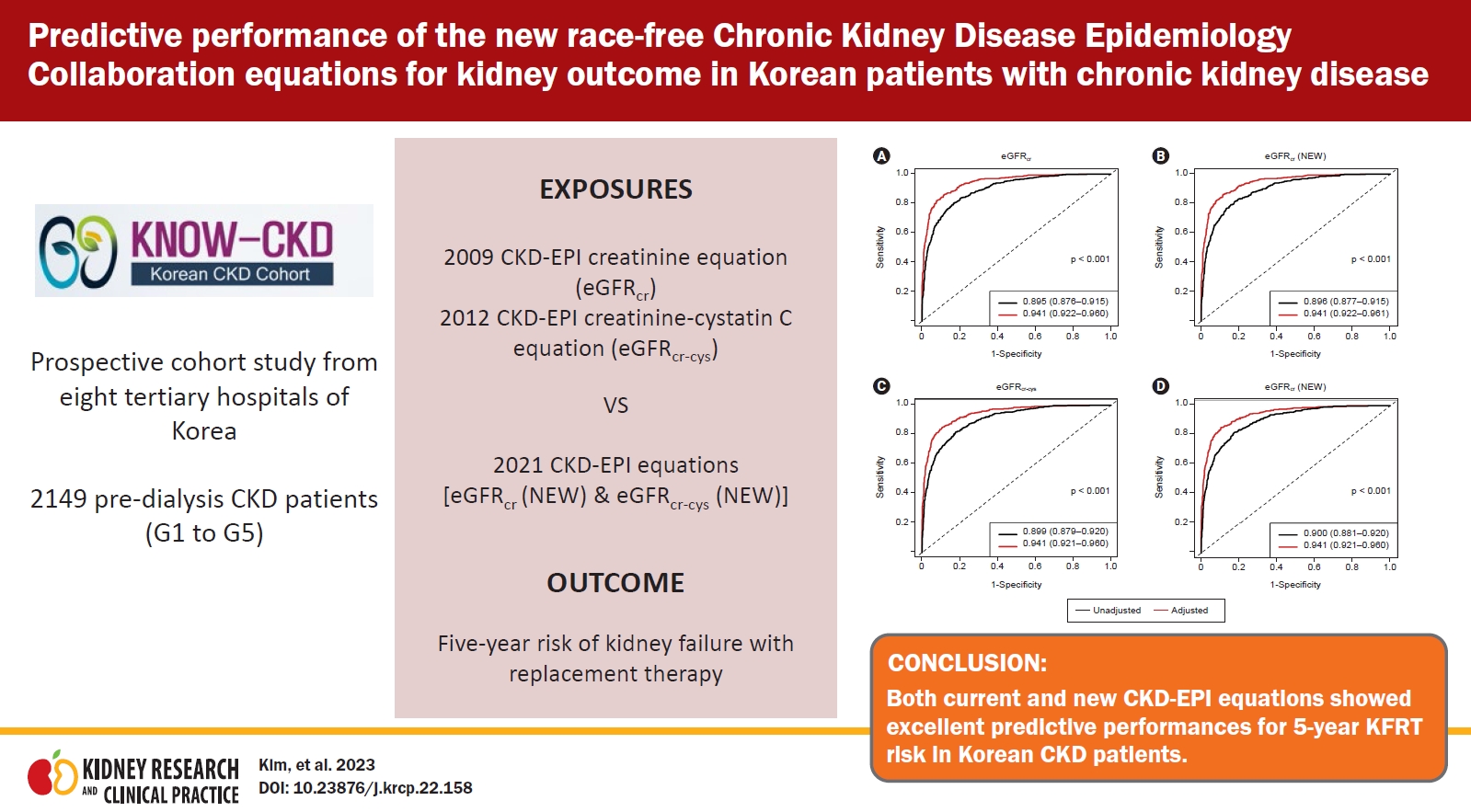| Kidney Res Clin Pract > Volume 42(4); 2023 > Article |
|
Abstract
Background
Methods
Results
Notes
Conflicts of interest
Tae-Hyun Yoo is the Editor-in-Chief of Kidney Research and Clinical Practice and was not involved in the review process of this article. All authors have no other conflicts of interest to declare.
Funding
This work was supported by the Research Program funded by the Korea Disease Control and Prevention Agency (2011E3300300, 2012E3301100, 2013E3301600, 2013E3301601, 2013E3301602, 2016E3300200, 2016E3300201, 2016E3300202, 2019E320100, 2019E320101, 2019E320102, 2022-11-007).
Data sharing statement
The data presented in this study are available on request from the corresponding author.
Authors’ contributions
Conceptualization: HK, SHH
Data curation: YYH, JYJ, JCJ, THY, KHO, SHH
Formal analysis: HK, YYH, HRY, YSJ, YK, JYJ, JCJ, JK
Funding acquisition, Project administration: KHO
Investigation: HK, YYH, HRY, YSJ, YK, JYJ, JCJ, JK, SHH
Methodology: JK, SHH
Resources: THY
Supervision: JTP, THY, SWK, KHO, SHH
Writing–original draft: HK, SHH
Writing –review & editing: YYH, HRY, YSJ, YK, JYJ, JCJ, JK, JTP, THY, SWK, KHO
All authors read and approved the final manuscript.
Supplementary Materials
Figure 1.
Bland-Altman plot for agreement between the current and new eGFR equations.

Figure 2.
Time-dependent receiver operating characteristic curves of eGFR equations for kidney failure with replacement therapy.

Table 1.
| Variable | Total |
CKD stage |
p for trend | |||||
|---|---|---|---|---|---|---|---|---|
| G1 | G2 | G3a | G3b | G4 | G5 | |||
| No. of participants | 2,149 | 390 | 447 | 351 | 447 | 403 | 111 | |
| Age (yr) | 53.8 ± 12.2 | 44.9 ± 11.7 | 52.4 ± 11.7 | 56.0 ± 11.2 | 57.1 ± 11.1 | 57.5 ± 11.2 | 56.7 ± 11.2 | <0.001 |
| Male sex | 1,315 (61.2) | 205 (52.6) | 302 (67.6) | 231 (65.8) | 269 (60.2) | 255 (63.3) | 53 (47.7) | 0.86 |
| Current smoker | 343 (16.0) | 67 (17.2) | 81 (18.2) | 59 (16.8) | 63 (14.1) | 58 (14.4) | 15 (13.5) | 0.003 |
| Diabetes mellitus | 728 (33.9) | 67 (17.2) | 98 (21.9) | 122 (34.8) | 189 (42.3) | 198 (49.1) | 54 (48.6) | <0.001 |
| Hypertension | 2,060 (95.9) | 341 (87.4) | 431 (96.4) | 345 (98.3) | 438 (98.0) | 397 (98.5) | 108 (97.3) | <0.001 |
| CVD history | ||||||||
| Total CVD | 289 (13.4) | 19 (4.9) | 44 (9.8) | 50 (14.2) | 84 (18.8) | 79 (19.6) | 13 (11.7) | <0.001 |
| Coronary heart disease | 132 (6.1) | 3 (0.8) | 19 (4.3) | 24 (6.8) | 39 (8.7) | 40 (9.9) | 7 (6.3) | <0.001 |
| Cerebrovascular disease | 132 (6.1) | 10 (2.6) | 21 (4.7) | 23 (6.6) | 36 (8.1) | 37 (9.2) | 5 (4.5) | <0.001 |
| Peripheral vascular disease | 77 (3.6) | 6 (1.5) | 11 (2.5) | 15 (4.3) | 23 (5.1) | 20 (5.0) | 2 (1.8) | 0.01 |
| Charlson comorbidity index | 2.3 ± 1.6 | 0.4 ± 0.8 | 1.6 ± 1.5 | 2.8 ± 1.2 | 3.1 ± 1.2 | 3.3 ± 1.2 | 3.2 ± 1.2 | <0.001 |
| Cause of CKD | ||||||||
| Glomerulonephritis | 767 (35.7) | 189 (48.5) | 188 (42.1) | 130 (37.0) | 131 (29.3) | 102 (25.3) | 27 (24.3) | |
| Diabetic nephropathy | 501 (23.3) | 25 (6.4) | 55 (12.3) | 76 (21.7) | 133 (29.8) | 164 (40.7) | 48 (43.2) | |
| Hypertensive nephropathy | 397 (18.5) | 19 (4.9) | 76 (17.0) | 76 (21.7) | 110 (24.6) | 96 (23.8) | 20 (18.0) | 0.03 |
| Polycystic kidney disease | 352 (16.4) | 135 (34.6) | 95 (21.3) | 44 (12.5) | 43 (9.6) | 24 (6.0) | 11 (9.9) | |
| Unclassified | 132 (6.1) | 22 (5.6) | 33 (7.4) | 25 (7.1) | 30 (6.7) | 17 (4.2) | 5 (4.5) | |
| Body mass index (kg/m2) | 24.3 ± 3.4 | 24.4 ± 3.9 | 24.5 ± 3.1 | 24.9 ± 3.4 | 24.7 ± 3.2 | 24.5 ± 3.4 | 24.3 ± 3.4 | 0.80 |
| SBP (mmHg) | 127.9 ± 16.1 | 126.4 ± 14.7 | 126.2 ± 14.3 | 127.2 ± 16.1 | 126.9 ± 15.4 | 130.7 ± 17.8 | 135.9 ± 20.4 | <0.001 |
| DBP (mmHg) | 77.1 ± 11.1 | 78.6 ± 11.1 | 77.4 ± 10.3 | 76.9 ± 10.7 | 75.6 ± 10.5 | 76.8 ± 12.5 | 77.6 ± 11.9 | 0.009 |
| Creatinine (mg/dL) | 1.8 ± 1.2 | 0.8 ± 0.2 | 1.1 ± 0.2 | 1.5 ± 0.2 | 1.9 ± 0.3 | 2.9 ± 0.6 | 5.0 ± 1.7 | <0.001 |
| Cystatin C (mg/dL) | 1.8 ± 0.9 | 0.8 ± 0.2 | 1.1 ± 0.2 | 1.5 ± 0.2 | 2.0 ± 0.4 | 2.8 ± 0.5 | 4.0 ± 0.7 | <0.001 |
| Hemoglobin (g/dL) | 12.8 ± 2.0 | 14.1 ± 1.5 | 13.8 ± 1.8 | 13.2 ± 1.9 | 12.4 ± 1.8 | 11.4 ± 1.6 | 10.4 ± 1.2 | <0.001 |
| Calcium (mg/dL) | 9.1 ± 0.5 | 9.3 ± 0.4 | 9.3 ± 0.4 | 9.2 ± 0.5 | 9.1 ± 0.5 | 8.9 ± 0.5 | 8.4 ± 0.9 | <0.001 |
| Phosphate (mg/dL) | 3.7 ± 0.7 | 3.5 ± 0.5 | 3.4 ± 0.5 | 3.5 ± 0.5 | 3.7 ± 0.6 | 4.0 ± 0.7 | 4.8 ± 0.8 | <0.001 |
| Albumin (g/dL) | 4.2 ± 0.4 | 4.3 ± 0.4 | 4.3 ± 0.4 | 4.2 ± 0.4 | 4.1 ± 0.4 | 4.0 ± 0.5 | 4.0 ± 0.5 | <0.001 |
| Total cholesterol (mg/dL) | 174.2 ± 39.3 | 184.1 ± 37.7 | 177.4 ± 36.2 | 173.8 ± 37.6 | 170.0 ± 39.4 | 168.5 ± 42.1 | 167.5 ± 44.5 | <0.001 |
| Triglyceride (mg/dL) | 157.7 ± 99.0 | 142.5 ± 86.3 | 144.1 ± 80.0 | 165.7 ± 113.8 | 168.9 ± 103.2 | 171.3 ± 113.0 | 145.7 ± 71.0 | <0.001 |
| hsCRP (mg/L) | 0.6 (0.2–1.7) | 0.4 (0.1–1.3) | 0.6 (0.3–1.4) | 0.6 (0.2–1.8) | 0.6 (0.3–1.7) | 0.8 (0.4–2.1) | 0.7 (0.2–1.8) | <0.001a |
| PTH (pg/mL) | 54.0 (34.9–88.4) | 36.0 (25.1–50.2) | 40.8 (28.0–57.9) | 50.1 (36.0–75.0) | 63.0 (44.3–91.8) | 98.1 (65.4–154.8) | 182.3 (116.0–305.6) | <0.001a |
| Urine PCR (g/g) | 0.5 (0.1–1.5) | 0.2 (0.0–0.7) | 0.3 (0.1–0.7) | 0.4 (0.1–1.3) | 0.6 (0.2–1.9) | 1.1 (0.4–2.6) | 1.7 (0.8–4.7) | <0.001a |
| RASB | 1,835 (85.4) | 313 (80.3) | 395 (88.8) | 312 (88.9) | 385 (86.1) | 337 (83.6) | 93 (83.8) | 0.73 |
| Statin | 1,120 (52.1) | 145 (37.2) | 226 (50.8) | 210 (59.8) | 261 (58.4) | 216 (53.6) | 62 (55.9) | <0.001 |
Data are expressed as number only, mean ± standard deviation, number (%), or median (interquartile range).
CKD, chronic kidney disease; CVD, cardiovascular disease; DBP, diastolic blood pressure; eGFR, estimated glomerular filtration rate; hsCRP, high-sensitive C-reactive protein; PCR, protein-to-creatinine ratio; PTH, parathyroid hormone; RASB, renin-angiotensin system blockade; SBP, systolic blood pressure.
Table 2.
Table 3.
Table 4.
| eGFR |
Unadjusted |
Adjusteda |
||||||||||
|---|---|---|---|---|---|---|---|---|---|---|---|---|
| AUC (95% CI) | p-value | IDI (95% CI) | p-value | Continuous NRI (95% CI) | p-value | AUC (95% CI) | p-value | IDI (95% CI) | p-value | Continuous NRI (95% CI) | p-value | |
| eGFRcr | 0.895 (0.876–0.915) | 0.02 | 0.002 (0.001–0.003) | <0.001 | 0.072 (0.005–0.158) | 0.04 | 0.941 (0.922–0.960) | 0.068 | 0.001 (0.000–0.001) | <0.001 | 0.156 (0.051–0.239) | <0.001 |
| eGFRcr (NEW) | 0.896 (0.877–0.915) | 0.941 (0.922–0.961) | ||||||||||
| eGFRcr-cys | 0.899 (0.879–0.920) | 0.002 | 0.002 (0.001–0.003) | <0.001 | 0.135 (0.018–0.264) | 0.03 | 0.941 (0.921–0.960) | 0.461 | 0.000 (–0.001 to 0.001) | 0.78 | –0.083 (–0.199 to 0.079) | 0.30 |
| eGFRcr-cys (NEW) | 0.900 (0.881–0.920) | 0.941 (0.921–0.960) | ||||||||||
AUC, area under the curve; CI, confidence interval; eGFR, estimated glomerular filtration rate; eGFRcr, eGFR based on creatinine with current equation; eGFRcr (NEW), eGFR based on creatinine with new equation; eGFRcr-cys, eGFR based on creatinine and cystatin C with current equation; eGFRcr-cys (NEW), eGFR based on creatinine and cystatin C with new equation; IDI, integrated discrimination improvement; NRI, net reclassification index.
References
- TOOLS
-
 PDF Links
PDF Links PubReader
PubReader ePub Link
ePub Link XML Download
XML Download Full text via DOI
Full text via DOI-
 Download Citation
Download Citation
 Supplement table 1
Supplement table 1 Supplement table 2
Supplement table 2 Supplement table 3
Supplement table 3 Supplement table 4
Supplement table 4 Supplement table 5
Supplement table 5 Supplement table 6
Supplement table 6 Supplement table 7
Supplement table 7 Supplement table 8
Supplement table 8 Supplement table 9
Supplement table 9 Supplement table 10
Supplement table 10 Supplement table 11
Supplement table 11 Supplement table 12
Supplement table 12 Supplement figure 1
Supplement figure 1 Supplement figure 2
Supplement figure 2 Supplement figure 3
Supplement figure 3 Supplement figure 4
Supplement figure 4 Supplement figure 5
Supplement figure 5 Supplement figure 6
Supplement figure 6 Print
Print-
Share :



-
METRICS

- ORCID iDs
-
Hyoungnae Kim

https://orcid.org/0000-0002-5359-0214Young Youl Hyun

https://orcid.org/0000-0002-4204-9908Hae-Ryong Yun

https://orcid.org/0000-0002-7038-0251Young Su Joo

https://orcid.org/0000-0002-7890-0928Yaeni Kim

https://orcid.org/0000-0002-2903-8374Ji Yong Jung

https://orcid.org/0000-0003-1271-8012Jong Cheol Jeong

https://orcid.org/0000-0003-0301-7644Jayoun Kim

https://orcid.org/0000-0003-2234-7091Jung Tak Park

https://orcid.org/0000-0002-2325-8982Tae-Hyun Yoo

https://orcid.org/0000-0002-9183-4507Shin-Wook Kang

https://orcid.org/0000-0002-5677-4756Kook-Hwan Oh

https://orcid.org/0000-0001-9525-2179Seung Hyeok Han

https://orcid.org/0000-0001-7923-5635 - Related articles

















